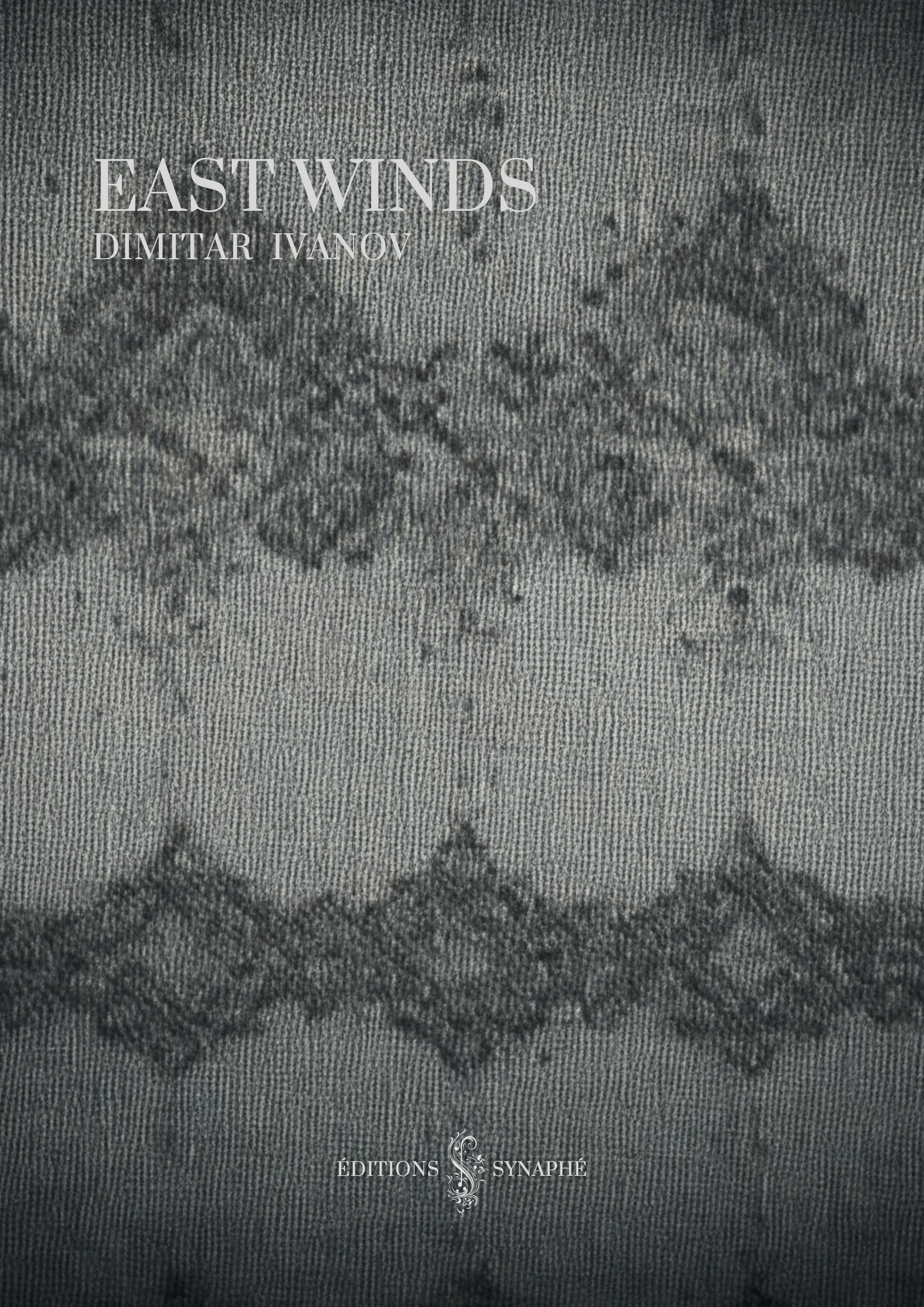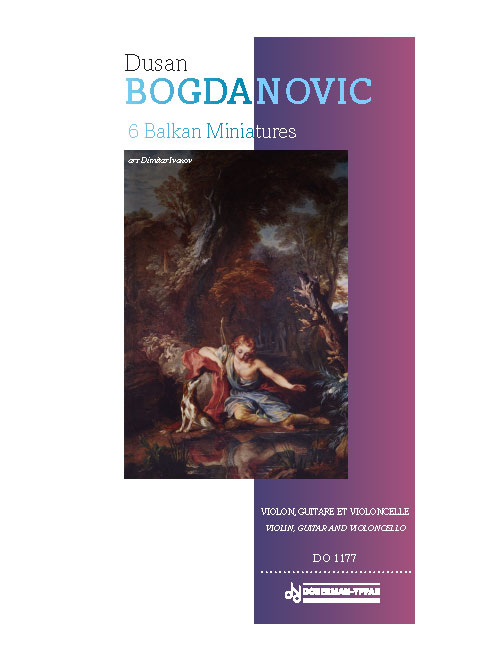Morceaux de Fantaisie Op. 3, No. 2 Prélude
This arrangement for two guitars includes an optional part for a 10-string guitar, equipped with additional strings in the lower register.
It is a revision of its original version recorded by the duo Synaphé for their album Classical Fragments in 2020, which had never been released before.
The arrangement transposes the power and emotion of the piano to the delicate sonority of the guitar, alternating between majestic moments and intimate passages. The rich sound of the guitar and the multi-string guitar adds a new dimension to this romantic classic, while preserving the dramatic intensity and sensitivity unique to the work.
Listen it here
Dimitar Ivanov, Caux, Switzerland 2025
East Winds
East Winds was composed for the debut of Balkan Moods, a quintet of renowned Bulgarian musicians. Premiered during a concert series in Switzerland in October 2024, the piece blends classical, jazz, and Balkan traditional styles.
Its improvisatory elements, complex rhythms, and melodic themes provide space for interpretative freedom between musicians with diverse classical, jazz, or Balkan traditional musical backgrounds.
The third guitar part includes advanced cross-rhythmic techniques that challenge musical dexterity and offers a multi-string guitar part.
Listen it here
Dimitar Ivanov, Caux, Switzerland 2024
The Ever Evolving Etude
This composition is written in 4/4 time with smaller rhythmic divisions through sixteenth notes passing mainly through two parallel melodic lines where both alternate between notes and rests. This movement gives defined staccato rhythms in a subtle pulse of salsa - basically a Cuban genre strongly developed in the eastern neighbourhoods of New York in the 1960s.
Dimitar Ivanov, Montreux, Switzerland 2024
Bianca
This piece is dedicated to the daughter of Egberto - Bianca. It is originally for 6 string guitar and is often integrated as a contrasting piece into the 10-string guitar repertory from the composer.
In order to highlight some of the musical shapes created from the the accent- changing voice Dimitar adds more harmony and accompany notes during the repetition of the first part of the piece.
The two parallel voices enchant within a feeling coming from a momentary perception of a new beginning.
Dimitar Ivanov, Montreux, Switzerland 2024
Fantasie No.1 “Mécanique” (2023)
The inspiration of this piece comes from the industrial tradition of the the automatons and music box production in the region of the Swiss town Sainte-Croix. In XIXth and XXth century almost all of the population of this entire region was implemented into the production of pieces for and the construction of automatons and music boxes. With generations of music box makers and traders the traditions were installed and found their triumph in the end of the XIX century. After the Second World War the production of small music boxes was saturated with large numbers of demands. Those were made mostly for American solders as it was a small and modern souvenir to transport back at the home continent.
With the modernisation, the strong concurence from Japan and others as well as the low and irregular salary for the workers slowly and continuously suppressed the manufacturers and the factories began to diminish. The old mechanical machines of all types, which were used to produce particules for the music boxes were sold or scraped.
At the end of the XXth century a Swiss Docteur named Jürg Wyss was passionate to collect and preserve those machines including thousands of music scores written on feather with the melodies from the cylinders of the music boxes that were build there. Some machines are now restored and the centuries old way of the production of the music box particles are currently alive in one atelier in Sainte-Croix. It is now part of the local art and science museum and is open for visits.
After I visited the atelier of Dr. Wyss I wrote this Fantasy No.1. I believe it preserves the main impression from this place and keeps many hints from there as the tempi from the working ancient machines, the general construction of the composition, the rotating fragments in crossed directions etc..
Today the tradition and it’s magic of the automatons and music box production is preserved with some of the world finest independent makers who are still living in Sainte-Croix as well as few local prestigious enterprises.
Dimitar Ivanov, Montreux / Sainte-Croix, Switzerland 2023
A collection of progressive exercises (2022)
EN
This collection (only in French language) is inspired by extensive research into existing methodologies for teaching the classical guitar. It has been produced with the support of guitarist and pedagogue George Vassilev and inspired by the advices of other classical guitar teachers.
The nine exercises are specifically dedicated to the problem of hand coordination for beginner guitarists.
The fingering combinations in the exercises are not exhaustive. Combinations with other fingers are possible. Combinations between exercises are also possible. It is recommended that these exercises be carried out in parallel with the study of the first melodies and pieces that the students learn.
FR
Ce recueil est inspiré des nombreuses recherches autour des méthodologies existantes pour l’enseignement de la guitare classique. Il a été réalisé avec le support du pédagogue et guitariste George Vassilev et inspiré par les conseils d’autres enseignants de guitare classique.
Les neuf exercices sont spécifiquement dédiés à la problématique de la coordination des mains des guitaristes débutants.
Les combinaisons de doigtés dans les exercices ne sont pas exhaustives. Des combinaisons avec d’autres doigts sont possibles. Des combinaisons entre les exercices sont également possibles. Il est recommandé de réaliser ces exercices parallèlement avec les études portant sur les premières mélodies et pièces qu’apprennent les élèves.
Dimitar Ivanov, Montreux, Switzerland 2022
Byzantine Theme and Variations (2022)
This work was performed and recorded originally for two guitars and percussions by Dusan Bogdanovic, Miroslav Tadic and Mark Nauseef and included in their album “Yano Mori” in 1999. Through the years the work finds different arrangements and versions for guitar and string quartet, written in 2002, for two guitars, guitar and oud or others. However they all remain with improvised character.
This new version for three guitars is written by synthesizing all existing materials until now and is preserving its improvised identity. Here for the first time is exposed a new third variation, which is written for solo guitar in rubato, unmeasured with melancholic song-like mood in accompaniment of bass and middle voices, evolving or resolving into different harmonies. Dusan Bogdanovic sketched the original melodic line together with the others variations in the year 1999, but it was never published until now.
The work is based on an ancient Byzantine melody by passing through contrasting complex dance rhythms evoking those on the Balkans in a deep, dream-like mood and creates an effect of a myth in storytelling to the listener.
The plasticity of this work opens to the performer new dimensions of improvisation or the creation of more personal, but coherent version.
Dimitar Ivanov, Montreux, Switzerland 2022
The Broken Balkan Polyrhythmic Etude (2020)
This Etude is a complex composition for solo guitar, which combines balkan rhythmic structures within polyrhythmics. The work includes an intruductional pedagogical part with three practices to polyrhythms. It demands to the player to go deeper into this matter before to start deciphering the etude and give a good preparation for the learning process of the the piece. Both the introduction and the piece can be worked independently.
It is an innovative and challengiang work, which achievement gives much of ease and flexibility into the performance of advanced rhythmics, fulfil good guitar-technical mastery and reflect a joyful mood to the audience.
Dimitar Ivanov, Montreux (Switzerland), 2020
Frédéric Chopin - 5 Valses, arr. for two guitars (2020)
This collection of five most popular waltzes (Grande Valse Brillante, op.18; Valse op.69, no.2; Valse “Minute”, op. 64, no.1; Valses op.64, no.2 and no.3) of Frederic Chopin unveils to the repertoire for two guitars. Their charm, elegance and contrasting romantic sensibility adapted to the classical guitar tone reinforce their intimacy and are a pleasure both to the performers and the audience.
The guitar parts share the exact written musical text by Chopin as the left and right hands of the pianist. Most evident way to arrange this piano music is to give each of the piano hand to one guitar part, but I preferred to intertwine them differently. The usual repetitive structure of those pieces permits to divide and distribute the solo parts and accompaniment section evenly to two guitars. In this way, knowing in details both of the guitar parts enlightens the interprets to their phrasing, articulation, dynamics and other musical features in any moment of their performance and can be either made in the same way or differently, but well-thought and assumed.
The guitar sonority of those piano masterpieces arises joyful curiosity to the audience and is a perfect addition to the guitarist’s repertoire for any occasion.
Dimitar Ivanov, Montreux (Switzerland), 2020
Ludwig van Beethoven - Symphony No. 7, Second Movement, Op. 92, arr. for two guitars (2020)
Allegretto – the second movement of Beethoven’s 7th symphony is one of the best known classical masterpieces. This movement has become an audience’s favorite ever since its first execution in Vienna in 1813, during a charity concert for the wounded soldiers of the battle of Hanau and is directed by Beethoven himself.
The work is often re-arranged by other composers and musicians for different solo or chamber music formations. During the last century it has becomes part of the soundtrack of more than twenty movies of different genres and TV series.
This arrangement of Allegretto for two guitars has been crafted essentially from the analysis of the orchestra score (Breitkopf und Härtel, 1863, Leipzig). The authenticity of the original proportions of all twelve different orchestra parts as well as the original keys have been kept in this arrangement for 2 guitars.
The arrangement is not affected by any personalisation or modification of the music and its performance became not only possible, but also transparent, comprehensively in ease and with excellent technical control.
Dimitar Ivanov, Schaffhausen (Switzerland), 2020
Dusan Bogdanovic - Six Balkan Miniatures, arr. for trio violin, guitar and cello (2018)
“These days of political turmoil in Eastern Europe find their focus especially in Yugoslavia, the heart of the Balkans, and my homeland. It is both tragic and ironic to see the further disintegration of the land and the people, while being aware of the unique cultural stamp of the whole area. So, it might be that the art among other universal human endeavours, still shows us a way of harmonising and synthesising the most diverse elements coming from the same source. It is in this spirit that I dedicate the music to World Peace.
All the six miniatures share characteristics of modally based harmony and flexible oddmeter. Overall, the forms are simple, based on repetition of phrases, often in different harmonic context. The Morning, Macedonian ant Tiny-knit Dances are all interrelated thematically and harmonically. The two songs present contrast in feeling and mood. The only literal quote of a dance is Vranjanka and the other mouvements, though based on ethnic music models, represent what Bartok named "un folklore imaginare". The Tiny-knit Dance alludes to the nimble fingers of "obligatory" Accordeon or furla (flute) players, one often hears in village weddings or other festivities.”
Dusan Bogdanovic, San Francisco, 1993










